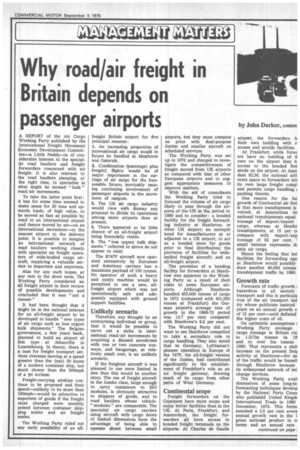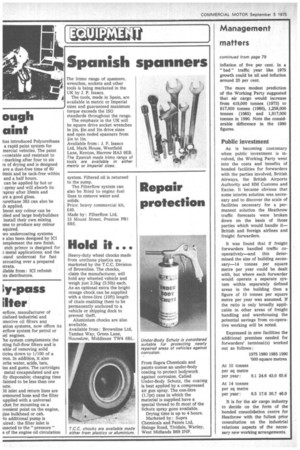Why road/air freight in Britain depends on passenger airports
Page 81

Page 82

If you've noticed an error in this article please click here to report it so we can fix it.
by John Darker, AMBIM
A REPORT of the Air Cargo Working Party published by the International Freight Movement Economic Development Committee—a Little Neddy—is of considerable interest to the specialist road hauliers and freight forwarders concerned with air freight. It is also relevant to the road hauliers planning, at the right time, to specialise in what might be termed "bulk " road/air movements.
To take the latter point first: it has for some time seemed to make sense for 20 tons and upwards loads, of high value, to be moved as fast as possible by road to an international airport and thence moved by air—on an international movement—to the nearest airport to the delivery point. It is possible to imagine an international network of road hauliers working closely with specialist air freight operators of wide-bodied cargo aircraft, supplying a valuable service to importers and exporters.
Alas for any such hopes, at any rate in the short term. The Working Party considered an all freight airport in their review of possible developments and concluded that it was "not a runner."
It had been thought that it might be in the national interest for an all-freight airport to be developed to handle "new types of air cargo such as less urgent bulk shipments.' The Belgian government, a .few years back, planned to build an airport of this type at Jehanville in Luxembourg, In theory, there is a case for freight transport services overseas moving at a speed greater than the (say) 30 knots of a modern container ship, but much slower than the 500mph of a jet airliner.
Freight-carrying airships continue to be proposed and their speed—unlikely to be more than 100mph—would be attractive to exporters of goods if the freight rates charged were sensibly poised between container shipping scales and air freight scales.
The Working Party ruled out any early possibility of an all freight British airport for five principal reasons: 1. An increasing proportion of international air cargo would in future be handled at Heathrow and Gatwick.
2. Combination (passenger plus freight) flights would be of major importance in the carriage of air cargo for the foreseeable future, inevitably causing continuing involvement of passenger airports in the movement of cargoes.
3. The UK air cargo industry would view with dismay any proposal to divide its operations among more airports than at present.
4. There appeared to be little chance of an all-freight airport being financially viable.
5. The "less urgent bulk shipments" referred to above do not appear to exist.
The B747F aircraft now operated extensively by European and American carriers has a maximum payload of 100 tonnes. No operator of such a heavy and costly machine would be permitted to use a new, allfreight airport which was not operationally safe and adequately equipped with ground support facilities.
Unlikely scenario
Therefore, any thought by an enterprising individual or group, that it would be possible to carve out a niche in international road/air movements by acquiring a disused aerodrome with one or two concrete runways, and hangarage, at relatively small cost, is an unlikely scenario.
If the freighter aircraft it was planned to use were limited in size then this would be another story. The use of freight aircraft in the Jumbo class, large enough to carry containers to ISO modules, is obviously attractive to shippers of goods, and to road hauliers whose vehicle" modules " are comparable. The specialist air cargo carriers using aircraft with cargo doors of limited dimensions have the advantage of being able to operate direct between small airports, but they must compete on price with dual-purpose Jumbo and smaller aircraft on scheduled services.
The Working Party was set up in 1972 and charged to investigate the competitiveness of freight moved from UK airports as compared with that of other European airports and to suggest appropriate measures to improve matters.
With the aid of consultants the Working Party tried to forecast the volume of air cargo likely to pass through the airports of the UK in the period to 1990 and to consider: a bonded facility for the freight forwarding industry at Heathrow, or other UK airport; an entrepOt bond for manufacturers at or adjacent to a UK airport, to act as a bonded store for goods prior to final distribution; the provision of facilities for widebodied freight aircraft; and an all-freight airport.
The provision of a bonding facility for forwarders at Heathrow was apparent to the Working Party as a result of their visits to some European airports. Although Heathrow handled 455,000 tonnes of cargo in 1973 (compared with 401,000 tonnes at Frankfurt) the German airport's average rate of growth in the 1969-73 period was 14.7 per cent compared with Heathrow's 9.2 per cent.
The Working Party did not want to see Heathrow compelled to take a secondary role in cargo handling. They also noted that in Germany, Lufthansa's pioneer operation in Europe of the 747F, the all-freight version of the Jumbo, had contributed significantly to the establishment of Frankfurt's role as an air freight gateway, drawing much of its cargo from other parts of West Germany.
Continental scope
Freight forwarders on the Continent have more scope and enjoy better facilities than in the UK. At Paris, Frankfurt, and Amsterdam, the freight forwarders all have access to bonded freight terminals on the airports. At Charles de Gaulle airport, the forwarders h. their own building with r access and airside facilities.
At Frankfurt, while form ers have no building of tl own on the airport they h access to the bonded frei sheds on the airport. At Amsi dam KLM, the national airl: rents space to forwarders wit its own large freight compl and permits cargo handling ; packing therein.
One reason for the fa( growth of Continental air frei is that more transhipment is volved; at Amsterdam ml national transhipments equal tonnage of import/export cargo, whereas at Heathr transhipments, at 15 per c( compare with import/exp tonnage of 82 per cent. small balance represents dc estic air cargo.
Hence the feeling that bet facilities for forwarding age at Heathrow would possibly duce another 40,000 tonnes transhipment traffic by 1980.
Growth rate
Forecasts of traffic growth hazardous in all sectors transport and this is particula true of the air transport ind try whose publicists insisted years on an annual growth r. of 15 per cent—until deflated the higher costs of oil.
On optimistic assumptions I Working Party envisage cargo tonnage in Britain risi to I217m tonnes in 19 and to over 3m tonnes 1990. That represents a sixfi increase on the present freii activity at Heathrow—for ml of the traffic would be funnell through Heathrow because its widespread network of int change services.
The Working Party avail themselves of some long-te: forecasting techniques develop by the National Ports Count who published United Kingd( International Trade in 1980 December, 1973. This formt assumed a 3.5 per cent avera annual growth rate in the I gross' national product in n terms and an annual rate inflation of five per cent. In a " bad " traffic year like 1975 growth could be nil and inflation around 25 per cent.
The more modest prediction of the Working Party suggested that air cargo would increase from 419,000 tonnes (1973) to 817,000 tonnes (1980), 1,258,000 tonnes (1985) and 1,917,000 tonnes in 1990. Note the considerable difference in the 1990 figures.
Public investment
As is becoming customary when public investment is involved, the Working Party went into the costs and benefits of bonded facilities for forwarders with the parties involved, British Airways, the British Airports Authority and HM Customs and Excise. It became obvious that some interim solution was necessary and to discover the scale of facilities necessary for a permanent solution the Heathrow traffic forecasts were broken down on the basis of those parties which would handle it— British and foreign airlines and freight forwarders.
It was found that if freight forwarders handled traffic cooperatively—and this determined the size of building necessary-14 tonnes per square metre per year could be dealt with, but where each forwarder would operate a separate system within separately defined areas in the building then a figure of 10 tonnes per square metre per year was assumed. If the ratio is only broadly applicable in other areas of freight handling and warehousing the potential savings from co-operative working will be noted.
Expressed in new facilities the additional premises needed for forwarders' terminal(s) worked out as follows : 1975 1980 1985 1990 '000 square metres At 10 tonnes per sq metre per year : 9.1 24.6 43.0 65.6 At 14 tonnes per sq metre per year : 6.5 17.6 30.7 46.9 It is for the air cargo industry to decide on the form of the bonded consolidation centre for Heathrow with the fullest prior consultation on the industrial relations aspects of the necessary new working arrangements.
























































































































